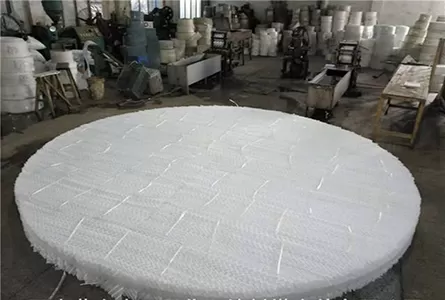plastic packing plays a vital role in various industrial processes by facilitating mass and heat transfer between fluids. This article will explain the working principle of plastic packing.
The core of plastic packing's working principle lies in enhancing the contact between different fluid phases, typically gas and liquid. When fluids pass through the packing, the unique structure of the plastic packing—such as its irregular surfaces, pores, or channels—creates a large number of contact points and a vast interfacial area. This increased contact area allows for more efficient interaction between the gas and liquid, which is essential for processes like absorption, distillation, and extraction.

In absorption processes, for example, the gas containing a target component flows upward through the plastic packing, while the liquid absorbent flows downward. As they come into contact with the packing's surface, the target component in the gas dissolves into the liquid. The plastic packing's structure ensures that the liquid spreads out over its surface, forming a thin film. This thin film maximizes the contact area between the gas and liquid, promoting the transfer of the component from the gas phase to the liquid phase.
Distillation relies on the difference in volatility between components in a mixture. The plastic packing provides a surface where the vapor (rising from the bottom) and the liquid (flowing from the top) can interact. The vapor condenses on the packing's surface, releasing heat, while the liquid vaporizes, absorbing heat. This exchange allows the more volatile components to move into the vapor phase and the less volatile ones to remain in the liquid phase, enabling separation. The packing's design ensures that this heat and mass transfer process occurs continuously and efficiently.
For heat transfer applications, plastic packing works by increasing the turbulence of the fluids. As fluids flow around the packing's structures, they are forced to change direction repeatedly, creating eddies and mixing. This turbulence breaks down the boundary layers that form around the fluid streams, reducing thermal resistance and allowing heat to transfer more readily between the fluids. Whether it is cooling a hot gas with a cold liquid or heating a liquid with a hot gas, the packing's ability to enhance fluid mixing accelerates the heat exchange process.

The structure of plastic packing is specifically designed to optimize these transfer processes. For instance,
structured packing has a uniform, ordered arrangement of corrugated sheets or grids, which guides the flow of fluids and ensures even distribution. This prevents channeling—where fluids flow through only a portion of the packing—and ensures that the entire volume of the packing is utilized for transfer.
random packing, on the other hand, consists of irregularly shaped pieces that create a tortuous path for fluids, promoting mixing and contact.
Additionally, the material properties of plastic packing contribute to its working principle. Plastics are often chosen for their chemical resistance, which allows them to withstand the corrosive fluids present in many industrial processes without degrading. Their surface properties, such as wettability, can also be modified to enhance the spreading of liquids, further improving contact and transfer efficiency.
In summary, the working principle of plastic packing revolves around maximizing the contact area and promoting efficient interaction between fluids, enabling effective mass and heat transfer. Its structure and material properties are tailored to optimize these processes, making it a key component in numerous industrial operations.



